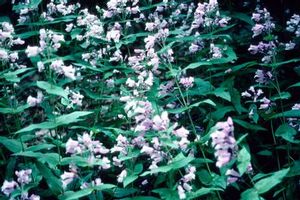Printed at http://www.newmoonnursery.com/index.cfm/
Penstemon smallii
Smalls penstemon
Native to North America
FIRST IMPRESSIONS: Penstemon smallii is an attractive perennial wildflower that expands to form upright bushy clumps. This beardtongue bears bright green heart shaped leaves with coarse teeth. In summer, plants are topped by showy panicles of tubular snapdragon-like lavender flowers. Pollinators flock to the blooms in sunny or partly shaded sites with well drained or dry soil.
HABITAT & HARDINESS: Penstemon smallii is a rare species that occurs in scattered montane habitats in five southeastern U. S. states (North Carolina, South Carolina, Tennessee, Georgia and Alabama).
This species is indigenous to margins of woods, rock outcrops, metamorphic or shale glades and barrens, rocky slopes, cliffs, banks, mountain coves and boulderfields,
Plants are hardy from USDA Zones 5-8.
PLANT DESCRIPTION: Penstemon smallii is an upright perennial that grows from a sturdy taproot.
In spring smooth green to purplish stems rise from attractive bronzy-red tinted winter rosettes.
The stems are clothed in bright green leaves with purple veins. The opposite leaves are rather large - up to 8” long and 3” across. Blades are heart shaped and glossy with serrate edges and pointed tips.
The stems terminate in large showy flower panicles. The branched panicles originate in the leaf axils so that full sized leaves are in close proximity to the flowers.
The florets are tubular, lobed and about 1.5” long. The outer surface of the corolla tube is pinkish-purple and the inner surface is white marked with purple nectar guides.
Blooming occurs in late spring or early summer for about six weeks. Florets are followed by small capsules containing many tiny seed.
Plants grow 1-2’ tall with 1’ spread.
CULTURAL & MAINTENANCE NEEDS: Penstemon smallii flourishes in sunny or partly sunny sites with acidic dry or moist soil. Plants tolerate alkaline pH, heat, humidity and loamy, sandy, clay, rocky or gravelly soils.
This species is pest resistant. It requires good drainage and is drought tolerant.
Plants are somewhat short lived (2-3 years) particularly in fertile soils. Happily, a seedling or two is generally waiting in the wings to fill available space.
LANDSCAPE USES: This is a good Groundcover for a Wildlife Garden, Cut Flower Garden, or Rock Garden. Plants are also used as Butterfly Nectar Plants or as part of a Grouping or Mass Planting. Penstemon smallii has Showy Blooms and is appropriate for Cottage Gardens, Deer Resistant Plantings, Water-wise Landscapes, Low Maintenance Plantings, Shade Gardens and Perennial Borders.
COMPANION & UNDERSTUDY PLANTS: Try pairing Penstemon smallii with Amsonia hubrichtii, Aster cordifolius, Carex rosea, Heuchera villosa, Phlox divaricata or Polystichum acrostichoides.
Penstemon calycosus has similar appearance and culture and could be substituted in some situations.
TRIVIA: Native bees, butterflies and hummingbirds sip nectar from the flowers. The leaves and stems are unpalatable to deer and other herbivores.
Penstemon smallii was named as the 1984 North Carolina Wildflower of the Year.
In the wild, Penstemon smallii is found mostly in rock outcrops. In the garden, this species generally flourishes in sun or open shade on thin infertile soil with good drainage.
The specific epithet and common name was given in honor of John Kunkel Small (1869-1938). Small was a taxonomist, researcher and botanical explorer who specialized in the flora of the southeastern United States.
Height:
1-2 ftSpread:
1 ftUSDA Hardiness Zone:
5-8Bloom Color:
PinkPenstemon smallii Characteristics
Attributes
- Dried Flower
Exposure
- Full Sun to Partial Shade
Flowering Months
- July
Foliage Color
- Green
Salt Tolerance
- Medium
Season of Interest (Foliage)
- Summer
- Spring
- Fall
Soil Moisture Preference
- Moist to Dry
Interesting Notes:
For more information on this plant, visit the USDA PLANTS Database: http://plants.usda.gov/java/profile?symbol=PESM

